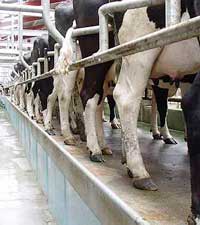Don’t let cell counts get out of hand

Rising cell counts is something not to be ignored. When looking at bulk milk, if cell counts have risen from 160,000 to 250,000 then something needs to be done.
Depending on the milk buyer the penalties vary; it may be that a new buyer needs to be found or that pence a litre are deducted. Changing to a buyer with no penalties can be useful in the short term, but herds with high cell counts need to act. When no action is taken it could be a slippery slope to the “legal” limit of 400,000.
The bulk tank figure is only an average of all the contributing cows. At 400,000 it could mean half the cows are at 100,000 and the other half at 700,000. Individual cell counts need to be monitored regularly before this type of situation occurs.
Cell counts are an indication there has been an infection in the udder, either clinical or sub-clinical mastitis. As the route of entry of this infection can only be the teat orifice, the investigation needs to show whether this has occurred in the dry period or during lactation and whether it has been caused by environmental or contagious bacteria.
Bacteriology on bulk tank, clinical and sub-clinical cases, can be helpful. Staph aureus, although not as common as it used to be, is a difficult infection to treat. This infection responds disappointingly to treatment both in the dry and lactation periods. The main emphasis now is to prevent the spread of this contagious infection through good milking routine practices.
There are various programmes helping identify problem areas, but just as important is making clinical case records accessible: Cow number, date and quarter and treatment. This is nothing new, but assessing when these cases occur compared to the calving date will assist in deciding whether a new intra-mammary infection has occurred during the dry or lactation period.
Once problem areas have been identified they need to be addressed. It may not mean vast capital expenditure, but simple changes in dry cow management. Culling chronic high cell cows without addressing poor management/routine practices is only a “quick fix” as these cows will shortly be replaced by new chronic high cell count cows.
Steve Borsberry is from 608 Vet Group, Solihull, a member of XLVets
